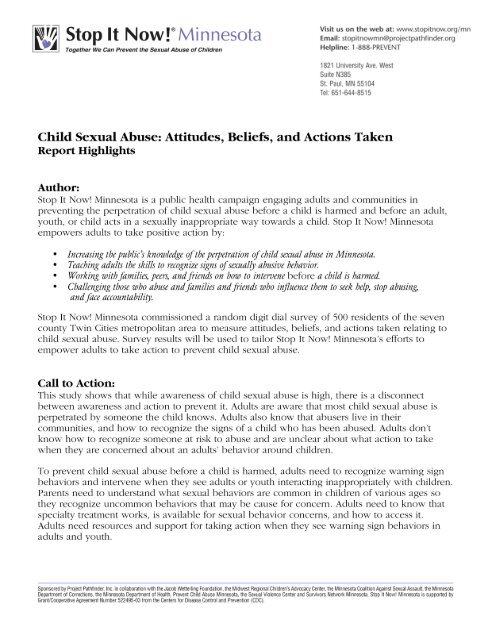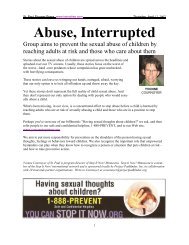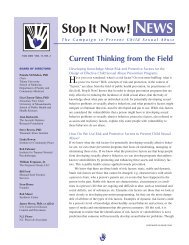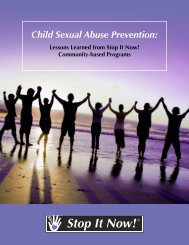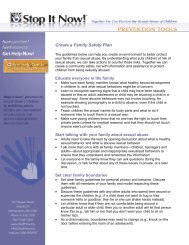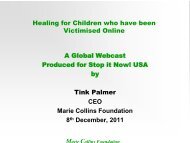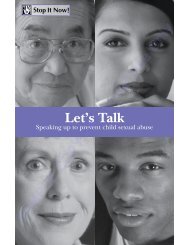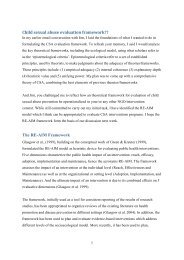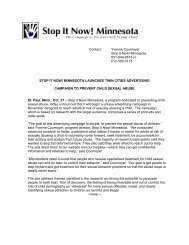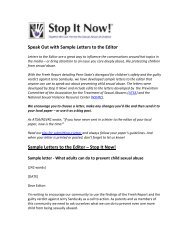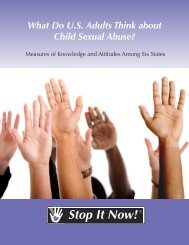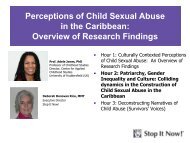Summary - Stop It Now
Summary - Stop It Now
Summary - Stop It Now
You also want an ePaper? Increase the reach of your titles
YUMPU automatically turns print PDFs into web optimized ePapers that Google loves.
Primary Findings:<br />
Awareness of child sexual abuse is high.<br />
<strong>Stop</strong> <strong>It</strong> <strong>Now</strong>! Minnesota’s survey indicates that residents are<br />
aware of the issue of child sexual abuse and believe it is a<br />
problem in Minnesota. Nearly all residents accurately define<br />
child sexual abuse using their own words. Residents are<br />
familiar with basic facts including that most sexually abused<br />
children are abused by someone the child knows, for<br />
example a parent, neighbor, or relative. They also believe<br />
that adults who abuse children may live in their community.<br />
Adults need to go beyond awareness of child sexual abuse<br />
to taking action to prevent child sexual abuse.<br />
Almost all (98.9%) residents are familiar with<br />
the term “child sexual abuse”.<br />
Almost all (97.9%) residents believe that most<br />
sexually abused children are abused by someone<br />
the child knows.<br />
The vast majority (86.4%) believe that abusers<br />
live within their communities.<br />
The vast majority (82.4%) believe that child<br />
sexual abuse is a problem in Minnesota.<br />
Nearly 1 out of 2 (46.2%) residents surveyed<br />
have talked with a friend, relative, or neighbor<br />
about child sexual abuse in the past year.<br />
Residents are more familiar with signs of a<br />
sexually abused child than signs of an adult who<br />
has sexually abused.<br />
Residents are familiar with signs of a child who has been<br />
abused. Recognizing abuse is important so the child gets<br />
the help they need to heal. To prevent child sexual abuse,<br />
adults also need to recognize and intervene when they see<br />
adults interacting inappropriately with children.<br />
Residents express interest in a public health campaign<br />
focusing on warning signs of sexual behavior problems and<br />
how to take action when they see those signs. Residents<br />
prefer to receive this information through brochures<br />
(38.1%), stories in the media (24.6%), a web site (22.8%), or<br />
as a component of a class, like a parenting class (9.2%).<br />
Nearly four out of five (78.2%) residents are able<br />
to respond when asked for warning signs of a<br />
child who has been sexually abused.<br />
Only two of five (40.5%) residents are able to<br />
respond when asked for characteristics or warning<br />
signs of an adult who has sexually abused a<br />
child.<br />
Nearly four out of five (76.6%) residents express<br />
an interest in receiving education materials<br />
regarding how to recognize signs of an adult at<br />
risk for abusing children and what people can do<br />
if they see those signs.<br />
Residents are positive towards treatment.<br />
Residents agree that abusers would like to receive help and<br />
that treatment would be helpful in stopping child sexual<br />
abuse, but are unclear where to refer them for help. About<br />
one in five (20.2%) would refer to police, one in 10 (10%)<br />
to child protective services and less than one in 10 (7.2%)<br />
to a counselor, human services, or Employee Assistance<br />
Program. Nearly four in 10 (37.8%) didn’t know anywhere<br />
to refer them.<br />
Almost eight out of 10 (76.8%) residents agree<br />
adults who sexually abuse children would like to<br />
receive help.<br />
More than half (56.4%) of residents agree<br />
appropriate treatment would be helpful in<br />
stopping child sexual abuse.<br />
To prevent child sexual abuse, people need to know that specialty treatment works, is available<br />
and how to access it.
Residents unclear about situations that involve<br />
sexual behavior between children or adolescents.<br />
Almost two-thirds of residents agree that many sexually<br />
abused children are abused by other children or<br />
adolescents. Almost one-fourth (23.1%) disagreed with<br />
this statement, however.<br />
When presented with several scenarios, residents<br />
generally agreed that scenarios in which adults expose<br />
themselves or touch a child in an inappropriate way are<br />
definitely sexual abuse. Residents are less confident<br />
about scenarios in which another child or teenager<br />
engages in inappropriate touching or sexual conduct<br />
with a younger child or teen.<br />
Parents need accurate information to understand what<br />
sexual behaviors are common in children of various ages<br />
so they recognize behaviors that are uncommon and may<br />
be cause for concern.<br />
Residents affected by child sexual abuse often didn’t<br />
tell adults and when they did tell, the abuse was<br />
often not reported to authorities.<br />
Our current system relies on someone reporting sexually<br />
abusive behaviors. But, if children don’t tell and adults<br />
who are told don’t report, then many child sexual abuse<br />
cases never come to the attention of authorities. The<br />
results of this survey indicate that for every victim we are<br />
aware of, there are as many as fourteen more who have<br />
either not disclosed or whose disclosures have not been<br />
reported.<br />
Nearly all (93.3%) residents agree that an adult<br />
bus driver exposing himself to a six year old on<br />
the bus is definitely sexual abuse.<br />
The vast majority (85.3%) agree that an adult<br />
family friend who touched the private parts of his<br />
neighbor who was ten years old is definitely<br />
sexual abuse.<br />
Over half (53.8%) agree that an eight-year-old<br />
boy touching the private parts of a 12-year-old<br />
boy at the request of the 12 year old is definitely<br />
sexual abuse.<br />
Over half (55.8%) agree that a 19-year-old<br />
woman engaging in a sexual relationship with a<br />
15-year-old boy is definitely sexual abuse.<br />
(NOTE: All scenarios meet the legal definition<br />
of sexual abuse.)<br />
More than one in five (21.5%) residents disclosed<br />
experiencing sexually abusive behavior by an<br />
adult or older child while they were children.<br />
Nearly seven in 10 (68.6%) residents who<br />
experienced sexually abusive behaviors did not tell<br />
an adult about the incident while still a child.<br />
Of residents who did tell an adult, nearly seven<br />
in 10 (67.9%) recalled that the incident was not<br />
reported to authorities.<br />
In addition to relying on children to report, we need to protect children before sexual abuse<br />
occurs. To do this we need to look at ways to encourage adults who have sexually abused a<br />
child to come forward, take responsibility, and get help to prevent further abuse.<br />
Residents unclear about what action to take when concerned an adult may be sexually<br />
abusing a child.<br />
A small proportion (3.0%) of residents surveyed had the experience of knowing an adult they<br />
were concerned may have been sexually abusing a child. When asked what action they took,<br />
almost one-third (32.2%) said they took no action relating to the abuse. Smaller proportions said<br />
they reported the abuse (15.8%), including calling the police (9.4%) or the local child protective<br />
services or DHS (6.4%); talked to the abuser or asked them about it (12.4%), talked with friends,<br />
doctors, or a minister or priest for advice (9.5%), or spoke with the child or the child’s parents<br />
to confirm the abuse (7.7%). Almost one fifth (17.1%) mentioned other actions, such as<br />
supporting another person who took action to prevent the abuse. Because the number of<br />
residents who answered this question was small, these findings should be interpreted<br />
cautiously.
Survey Methodology<br />
Market Street Research of Massachusetts conducted this study. A total of 500 residents were<br />
surveyed (200 from Hennepin County, 100 from Ramsey, 50 each from Anoka, Dakota, and<br />
Washington County, and 50 total from Carver and Scott Counties). Respondents’ telephone<br />
numbers were generated using the Random Digit Dialing (RDD) procedure. Interviewers<br />
randomly chose an adult age 18 or over to interview. Interviewing was conducted from March 5<br />
to March 23, 2003. The response rate for this study was 32.2%.<br />
Some counties were over-sampled to draw statistically accurate conclusions by county. To<br />
account for this disproportionate sampling, results were weighted based on actual population<br />
distribution. In addition, to factor for older residents being more likely to participate in<br />
telephone interviews, results were weighted to accurately reflect the actual age distribution in<br />
the survey area. Weighting is based on 2000 U.S. Census population estimates for each county<br />
surveyed.<br />
All surveys involve a margin of error. The margin of error for this study is plus or minus 2.6 to<br />
4.4 percentage points. Findings reported as significant indicate there is a 95% or greater chance<br />
the difference is real and not due to sampling error.<br />
The full report is available at www.stopitnow.org/mn<br />
Demographics<br />
This survey collected information on respondents’ sex, age, highest level of education, marital<br />
status, parental status, whether children under the age of 18 live in the home, and race and<br />
ethnicity. Our sample was compared to 2000 U.S. Census population estimates.<br />
The chart below shows where survey respondents differ demographically from 2000 U.S. Census<br />
population estimates.<br />
Survey Respondents Census Estimates<br />
Men 38.3% 48.6%<br />
Women 61.7% 51.4%<br />
White residents 89.4% 86.2%<br />
Hispanic or Latino residents 1.5% 3.1%<br />
African American or Black 3.0% 4.9%<br />
Residents with Some College 79.3% 66.6%<br />
Residents with Advanced Degree 20.2% 10.7%


